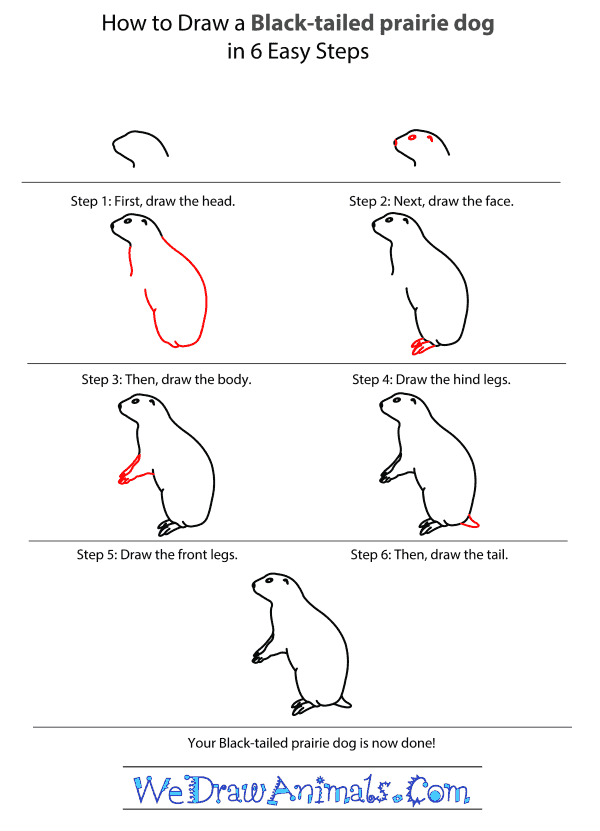In this quick tutorial you'll learn how to draw a Black Tailed Prairie Dog in 6 easy steps - great for kids and novice artists.
The images above represent how your finished drawing is going to look and the steps involved.
Below are the individual steps - you can click on each one for a High Resolution printable PDF version.
At the bottom you can read some interesting facts about the Black Tailed Prairie Dog.
Make sure you also check out any of the hundreds of drawing tutorials grouped by category.
How to Draw a Black Tailed Prairie Dog - Step-by-Step Tutorial
Step 1: First, draw the oval-shaped head of the prairie dog attached to a short line for the neck.
Step 2: Next, draw the face by making a small semi-circle at the tip of your oval for the nose. Draw a circle for the eye where your prairie dog's head curves slightly inward. To make the ear, draw an upside down U shape at the back of the head.
Step 3: Then, draw the body using one short line for the chest and one long line that attaches to the back of the head and curves up to almost meet the line you made for the chest. Don't forget to make a short line where you want to show the belly of your prairie dog.
Step 4: Draw the hind legs using two U shapes that stick directly out from the bottom of the prairie dog's body. Add one short line to each foot to create the separation of it's toes.
Step 5: Draw the front legs by having two lines extend from the upper body and slightly point into the shape of the paws. For the leg furthest from you, simply draw a line that is above the closest, more detailed paw. Have this leg end closer to the body than the left leg.
Step 6: Then, draw the tail by making a cone-shape that is attached to the rump of your Black prairie dog.
Interesting Facts about the Black-Tailed Prairie Dog
Black-tailed prairie dogs (Cynomys ludovicianus) are native to North America. They used to be the most common prairie dog in the United States, but due to their habitat being used as grazing ground for farm animals as well as farmers and hunters exterminating them as pests, their numbers have lowered.
Did you know?
- Although they are named for their dog-like yip, prairie dogs are actually rodents and similar to squirrels.
- They are tan or brown, and these prairie dogs get their name from the black tip at the end of their tails.
- Unlike other prairie dogs, black-tailed prairie dogs do not hibernate during the winter. They can sometimes be seen out of their burrows and outside during the winter.
- They live inside burrows in prairies with short grass.
- The male black-tailed prairie dog is larger than the female.
- The black-tailed prairie dog can be told apart from other prairie dogs not only by its tail, but also because of the areas where they live.
- They live in colonies that can range from five to thousands of other prairie dogs.
Lesson plan note: Discuss how farms, ranches, and changes to the environment due to grazing animals have caused the prairie dog population to drop over the years.







